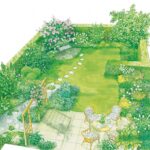Ideas for small Japanese gardens have captured the imagination of many homeowners and landscape enthusiasts. The allure of these tranquil and harmonious spaces has made them a popular choice for those looking to infuse their outdoor areas with a sense of calm and beauty. In this article, we will delve into the key elements and principles of traditional Japanese garden design, with a specific focus on how to adapt these ideas for smaller spaces.
Japanese gardens are renowned for their serene beauty and thoughtful design, often incorporating elements such as water features, stone pathways, and carefully chosen plants and trees. While large-scale Japanese gardens are breathtaking in their own right, small Japanese gardens can be equally captivating, offering an intimate and peaceful retreat within limited space.
In the following sections, we will explore the essence of Japanese garden design and discuss how to incorporate essential elements into small-scale landscapes. From choosing the right plants and trees to creating a serene stone pathway, we will provide practical tips and ideas for maximizing the beauty and tranquility of small Japanese gardens. Whether you have a compact backyard or a tiny balcony, these ideas can help you create your own little slice of Zen-inspired paradise.
The Essence of Japanese Garden Design
Japanese garden design is deeply rooted in tradition and reflects the principles of harmony, balance, and simplicity. The main focus of Japanese garden design is to create a serene and peaceful space that harmonizes with nature. This is achieved through the use of key elements such as rocks, water, plants, and ornaments. These elements are carefully arranged to evoke a sense of tranquility and contemplation, making Japanese gardens an ideal choice for small spaces.
One of the most prominent features of Japanese garden design is the concept of “borrowed scenery,” which incorporates surrounding natural elements such as trees, hills, or distant mountains into the garden composition. This creates a seamless transition between the garden and its surroundings, making it feel like an extension of the natural landscape. In small Japanese gardens, this principle can be adapted by strategically positioning trees or shrubs to frame views and create a sense of depth.
Another essential aspect of Japanese garden design is the careful selection and placement of rocks and stones. These elements are used to symbolize mountains, islands, or other natural formations within the garden. In smaller gardens, rocks can be arranged to create miniature landscapes that convey a sense of scale and proportion. Additionally, gravel or pebble pathways can be incorporated to represent flowing water or ripples in a pond.
The use of evergreen plants such as bonsai trees, mosses, and ferns is also crucial in traditional Japanese garden design. These plants provide year-round greenery and contribute to the overall sense of calmness and continuity within the space. For small Japanese gardens, choosing compact varieties of these plants can help maximize limited space while still achieving the desired aesthetic effect.
| Japanese Garden Design Elements | Adaptation for Small Gardens |
|---|---|
| Borrowed Scenery | Strategic positioning to frame views in small spaces |
| Rocks and Stones | Arrangement for creating miniature landscapes |
| Evergreen Plants | Selection of compact varieties for limited space |
Choosing the Right Plants and Trees
Popular Plants and Trees
Japanese gardens are known for their lush greenery, so it’s important to choose plants and trees that thrive in a small space. Some popular choices include evergreen shrubs like Japanese maple, bamboo, and azaleas. These options provide vibrant colors and textures while remaining relatively compact.
Low-Maintenance Options
For those looking to minimize the upkeep of their small Japanese garden, there are plenty of low-maintenance plant options to consider. Ground covers like moss and ferns can add a touch of green without requiring much attention. Additionally, incorporating drought-tolerant plants can help reduce the need for constant watering and care.
Visually Impactful Greenery
Incorporating visually impactful plants and trees can add depth and interest to a small Japanese garden. Consider using ornamental grasses for dynamic movement, or flowering plants like cherry blossoms for seasonal bursts of color. By carefully choosing a variety of greenery, you can create a visually stunning landscape in your small garden space.
When selecting plants and trees for your small Japanese garden, be sure to consider the overall aesthetic you wish to achieve as well as practical considerations such as light exposure and soil conditions. With careful planning and selection, you can create a lush and serene oasis within your limited outdoor space.
Incorporating Tranquil Water Features
Water features are an essential element in traditional Japanese garden design, known for their tranquil and peaceful ambiance. In small Japanese gardens, the addition of water features can create a sense of serenity and enhance the overall aesthetic. From small ponds to minimalist fountains or water basins, there are various options for incorporating water elements in limited spaces.
Benefits and Considerations
The addition of a water feature in a small Japanese garden not only adds visual interest but also contributes to the relaxing atmosphere. The sound of flowing water can create a calming effect, making it an ideal choice for urban areas or compact outdoor spaces.
When integrating water features, it is important to consider factors such as maintenance, space constraints, and safety. It’s crucial to choose a water feature that complements the size and style of the garden while being mindful of any potential maintenance challenges.
Design and Placement
When choosing a water feature for your small Japanese garden, consider its placement to maximize its impact. A compact pond surrounded by carefully selected plants can create a stunning focal point, while a simple stone basin with running water can add tranquility without taking up too much space. It’s essential to ensure that the design and placement of the water feature harmonize with the rest of the elements in the garden, maintaining balance and cohesion.
Maintenance Considerations
To keep your small Japanese garden looking its best, proper maintenance of water features is crucial. Regular cleaning and upkeep are necessary to prevent algae growth or debris accumulation.
Additionally, ensuring that any pumps or filtration systems are functioning properly is essential for maintaining both the visual appeal and functionality of the water feature within limited space. By incorporating manageable water elements and staying on top of maintenance tasks, you can enjoy all the benefits that these tranquil features bring to your small Japanese garden.
Creating a Serene Stone Pathway
When it comes to designing a small Japanese garden, the incorporation of a serene stone pathway is essential for creating a sense of tranquility and harmony within the space. By carefully selecting and arranging stepping stones, gravel, and pebbles, you can enhance the visual appeal of your garden while also providing a practical pathway for strolling and contemplation. Here are some ideas for designing a peaceful and visually appealing pathway in your small Japanese garden:
- Utilize natural materials: When creating a stone pathway in your small Japanese garden, it’s important to use natural materials such as flagstone, river rocks, or crushed gravel. These materials not only complement the overall aesthetic of the garden but also evoke a sense of calmness and simplicity.
- Embrace asymmetry: In traditional Japanese garden design, asymmetry is often favored over strict symmetry. When laying out your stone pathway, consider creating meandering curves and irregular spacing between the stepping stones to mimic the organic flow of nature.
- Integrate moss and ground cover: To add texture and soften the look of your stone pathway, consider incorporating patches of moss or low-growing ground cover plants between the stepping stones. This not only adds visual interest but also helps to blend the pathway seamlessly into the surrounding landscape.
By following these ideas for creating a serene stone pathway in your small Japanese garden, you can elevate the overall ambiance of your outdoor space while staying true to the timeless principles of Japanese garden design. Whether you opt for a simple gravel path or a more elaborate arrangement of stepping stones, the key is to keep the design harmonious and in tune with nature.
Maximizing Space With Strategic Arrangement
When it comes to creating a small Japanese garden, maximizing the limited space available is key to achieving a serene and harmonious outdoor sanctuary. With strategic arrangement, even the smallest of spaces can be transformed into a tranquil and visually appealing garden. Here are some ideas for utilizing limited space to create a sense of depth and openness:
- Vertical gardening: Utilize trellises, hanging baskets, and wall-mounted planters to add greenery without taking up precious horizontal space. Climbing plants like jasmine or wisteria can add vertical interest and provide shade.
- Multi-functional elements: Incorporate garden elements such as seating areas with built-in storage, or benches that double as planters. This allows for practical use of space while also adding visual appeal.
- Layering and tiered arrangements: Create depth in the garden by using varying heights and levels. Layering plants, arranging rocks of different sizes, or incorporating raised platforms can give the illusion of more space.
These strategies for strategic arrangement in small Japanese gardens allow for the creation of a peaceful and visually pleasing outdoor sanctuary despite limited square footage.
In addition to the aforementioned ideas, selecting the right kind of plants and trees can further enhance the illusion of space in a small Japanese garden. Low-maintenance greenery such as bamboo, ferns, moss, or dwarf trees not only add natural beauty but also require minimal upkeep. Creating harmony within limited space through strategic arrangement is fundamental to traditional Japanese garden design principles-achieving simplicity, balance, and tranquility amidst spatial constraints.
Adding Decorative Elements and Ornaments
When it comes to creating a small Japanese garden, decorative elements and ornaments play a crucial role in enhancing the overall aesthetic and invoking a sense of tranquility. Traditional Japanese gardens often feature iconic accents such as lanterns, pagodas, and garden statues that not only add visual interest but also carry cultural significance. These decorative elements can be incorporated into small-scale gardens to create a serene and harmonious space.
One popular decorative element for small Japanese gardens is the stone lantern, known as “ishidoro.” These ornate lanterns are typically made of granite or basalt and come in various styles such as tachi-gata (standing), yukimi-gata (snow-viewing), or oki-gata (portable). Placing a stone lantern strategically within the garden can add a touch of elegance while also serving as functional lighting for evening ambiance.
Pagodas, another iconic feature in traditional Japanese gardens, can also be adapted for smaller spaces. These tiered structures symbolize enlightenment and are often used as focal points within the garden. Incorporating a miniature pagoda or even a pagoda-shaped ornament can add height and visual interest to the landscape without overwhelming the limited space.
In addition to traditional elements, modern decorative ornaments like bamboo water spouts, wind chimes, and bamboo fences can be used to infuse a contemporary touch into small Japanese gardens. These versatile decorative pieces not only add flair but also contribute to the overall sensory experience by creating soothing sounds and enhancing the natural ambiance.
By carefully selecting and arranging these decorative elements and ornaments, individuals can transform their small outdoor spaces into enchanting retreats that embody the timeless allure of Japanese garden design. Whether embracing tradition or adding a contemporary twist, these accents play a key role in achieving harmony and balance within a small Japanese garden.
Maintenance Tips for Small Japanese Gardens
Maintaining the beauty and tranquility of a small Japanese garden requires careful attention and consistent upkeep. To ensure that your garden remains a peaceful oasis, it is important to follow some maintenance tips specifically tailored for small Japanese gardens.
One key aspect of maintaining a small Japanese garden is regular pruning and weeding. As these gardens often feature carefully manicured plants and trees, it’s essential to keep them tidy and well-groomed. Additionally, removing weeds promptly will help preserve the clean and serene look of the garden.
Another important maintenance tip for small Japanese gardens is to regularly inspect and clean any water features, such as ponds or fountains. Ensuring that these elements are free from debris or algae buildup will help maintain the overall harmony and visual appeal of the garden. Properly circulating water also prevents stagnation, which can attract insects and compromise the tranquility of the space.
In addition to these tasks, general upkeep such as raking gravel pathways and refreshing mulch or pebbles may be necessary to keep the garden looking pristine. By staying on top of these maintenance tasks, you can ensure that your small Japanese garden remains a peaceful retreat for contemplation and relaxation.
As you consider creating or tending to your own small Japanese garden, incorporating these maintenance tips will help keep your outdoor sanctuary in top condition for years to come.
Conclusion
In conclusion, small Japanese gardens offer a beautiful and serene escape, even within limited space. By understanding the essence of Japanese garden design and incorporating key elements such as plants, water features, stone pathways, strategic arrangement, and decorative elements, it is possible to create an oasis of tranquility in any small backyard or outdoor area. With the right maintenance and upkeep, these miniature landscapes can serve as a source of inspiration and relaxation for their owners.
For those seeking ideas for small Japanese gardens, this article has provided valuable insights into the fundamental principles of traditional Japanese garden design. From selecting the right plants and trees to incorporating tranquil water features and creating serene stone pathways, there are numerous ways to maximize the potential of a small space. Additionally, by adding decorative elements and ornaments while strategically arranging garden elements, individuals can enhance the aesthetic appeal of their miniature oasis.
Ultimately, whether you are an experienced gardener or a novice enthusiast, finding inspiration for your small Japanese garden is all about embracing the beauty of simplicity and harmony. It is important to remember that a successful small Japanese garden is not solely defined by its physical attributes but also by the sense of peace and tranquility it evokes.
As you embark on your journey to create your own miniaturized haven inspired by Japanese gardening traditions, let this be a reminder that even within limited space, there lies boundless potential for beauty and serenity.

Welcome to my gardening blog! I am passionate about plants and enjoy sharing my knowledge and experiences with others. In this blog, I will write about everything related to gardening, from tips on how to get started to updates on my own garden projects.





